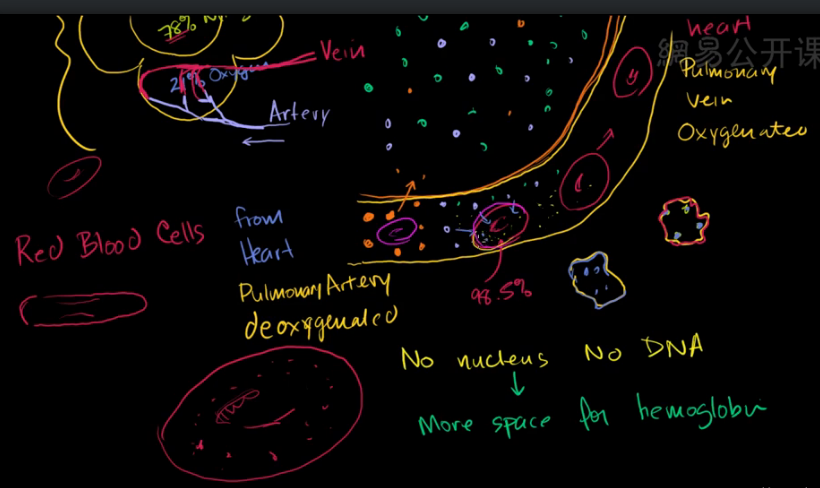Where I left off in the last video,
上集視頻中
we talked about how the hemoglobin in red blood cells is what sops up all of the oxygen
我們介紹了紅細(xì)胞中的血紅蛋白是吸收氧氣的地方
so that it increases the diffusion gradient
所以血紅蛋白會(huì)增加血液中的擴(kuò)散梯度
or it increases the incentive, we could say, for the oxygen to go across the membrane.
或者說,促進(jìn)氧氣透過細(xì)胞膜擴(kuò)散
We know that the oxygen molecules don't know that there's less oxygen here,
氧氣分子本身并無法判斷什么地方氧氣濃度更低
but if you watch the video on diffusion you know how that process happens.
但如果看擴(kuò)散的視頻的話,大家會(huì)看到這個(gè)過程
If there's less concentration here than there,
如果某地方濃度要小于別的地方
the oxygen will diffuse across the membrane
氧氣就會(huì)透過細(xì)胞膜進(jìn)行滲透
and there's less inside the plasma because the hemoglobin is sucking it all up like a sponge.
所以血漿中氧氣濃度很低,因?yàn)檠t蛋白像海綿吸水一樣把氧氣都吸收了

Now, one interesting question is,
這里有一個(gè)很有意思的問題
why does the hemoglobin even have to reside within the red blood cells
為什么血紅蛋白要在紅細(xì)胞中呢?
Why aren't hemoglobin proteins just freely floating in the blood plasma?
為什么不直接讓血紅蛋白在血漿中流動(dòng)呢?
That seems more efficient.
這樣看起來擴(kuò)散更有效率
You don't have to have things crossing through, in and out of, these red blood cell membranes.
因?yàn)檫@樣的話,氧氣不用再透過細(xì)胞膜進(jìn)行擴(kuò)散了
You wouldn't have to make red blood cells.
這樣也不用專門生成紅細(xì)胞了
What's the use of having these containers of hemoglobin?
那么為什么還要把血紅蛋白放在紅細(xì)胞里呢?
It's actually a very interesting idea.
這個(gè)很有意思
If you had all of the hemoglobin sitting in your blood plasma, it would actually hurt the flow of the blood.
如果把血紅蛋白直接放在血漿里,這樣會(huì)妨礙血液流動(dòng)
The blood would become more viscous or more thick.
血液會(huì)變得更加粘稠
I don't want to say like syrup, but it would become thicker than blood is right now
說很像糖漿可能不太恰當(dāng),但血液確實(shí)會(huì)比現(xiàn)在更粘稠
and by packaging the hemoglobin inside these containers, inside the red blood cells,
而如果把血紅蛋白包裹在細(xì)胞中,由紅細(xì)胞來運(yùn)送
what it allows the blood to do is flow a lot better.
這樣血液流動(dòng)更流暢
Imagine if you wanted to put syrup in water.
假設(shè)大家把糖漿倒在水里
If you just put syrup straight into water, what's going to happen?
直接倒在水里的話,會(huì)怎樣呢?
The water's going to become a little syrupy, a little bit more viscous and not flow as well.
水會(huì)變得粘稠起來,流動(dòng)就不順暢了
So what's the solution if you wanted to transport syrup in water?
那么,怎么解決這個(gè)問題呢?
Well, you could put the syrup inside little containers or inside little beads
我們可以用小容器把糖漿先裝起來,比方說小珠子內(nèi)部裝糖漿
and then let the beads flow in the water
然后讓小珠子在水里流動(dòng)
and then the water wouldn't be all gooey and that's exactly what's happening inside of our blood.
這樣水就不會(huì)變得黏稠,這也是血液中的情況
Instead of having the hemoglobin sit in the plasma and make it gooey,
血紅蛋白直接在血漿中,血液就會(huì)非常黏稠
it sits inside these beads that we call red blood cells that allows the flow to still be non-viscous.
但如果放在紅細(xì)胞中血液就不那么黏稠
So I've been all zoomed in here on the alveolus and these capillaries,
我們看放大圖里的肺泡和毛細(xì)血管
these pulmonary capillaries-- let's zoom out a little bit-- or zoom out a lot-- just to understand, how is the blood flowing?
這些肺部毛細(xì)血管--我們從宏觀上看一下,看血液是怎么流動(dòng)的
And get a better understanding of pulmonary arteries and veins relative to the other arteries and veins that are in the body.
要看肺部的動(dòng)脈和靜脈區(qū)別于身體中的其他靜脈和動(dòng)脈的工作原理



